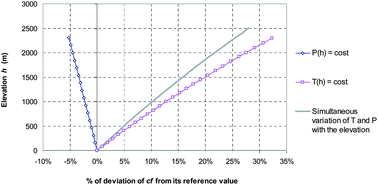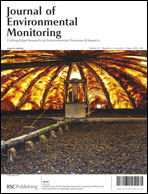Passive samplers are often employed to measure ozone concentrations in remote areas such as mountain forests. The potential ozone risk for vegetation is then assessed by calculating the AOT40 exposure index (accumulated hourly ozone concentration exceedances above 40 ppb, i.e. AOT40 = Σ([O3] − 40)Δt for any hourly ozone concentration [O3] > 40 ppb). AOT40 is customary calculated on the basis of ozone concentrations expressed as a volumetric mixing ratio, while lab sheets normally report ozone concentrations from passive samplers in mass units per cubic metre. Concentrations are usually converted from mass units to ppb using a standard conversion factor taking SATP (Standard Ambient Temperature and Pressure) conditions into account. These conditions, however, can vary considerably with elevation. As a consequence, the blanket application of a standard conversion factor may lead to substantial errors in reporting and mapping ozone concentrations and therefore in assessing potential ozone risk in mountain regions. In this paper we carry out a sensitivity analysis of the effects of uncertainties in estimations of air temperature (T) and atmospheric pressure (P) on the concentration conversion factor, and present two examples from two monitoring and mapping exercises carried out in the Italian Alps. We derived P and T at each site from adiabatic lapse rates for temperature and pressure and analysed the magnitude of error in concentration estimations. Results show that the concentration conversion is much more sensitive to uncertainties in P gradient estimation than to air temperature errors. The concentration conversion factor (cf) deviates 5% from the standard transformation at an elevation of 500 m asl. As a consequence, the standard estimated AOT40 at this elevation is about 13% less than the actual value. AOT40 was found to be underestimated by an average between 25% and 34% at typical elevations of mountain forest stands in the Italian Alps when a correct conversion factor for transforming ozone concentrations from μg m−3 to ppb is not applied.

You have access to this article
 Please wait while we load your content...
Something went wrong. Try again?
Please wait while we load your content...
Something went wrong. Try again?


 Please wait while we load your content...
Please wait while we load your content...